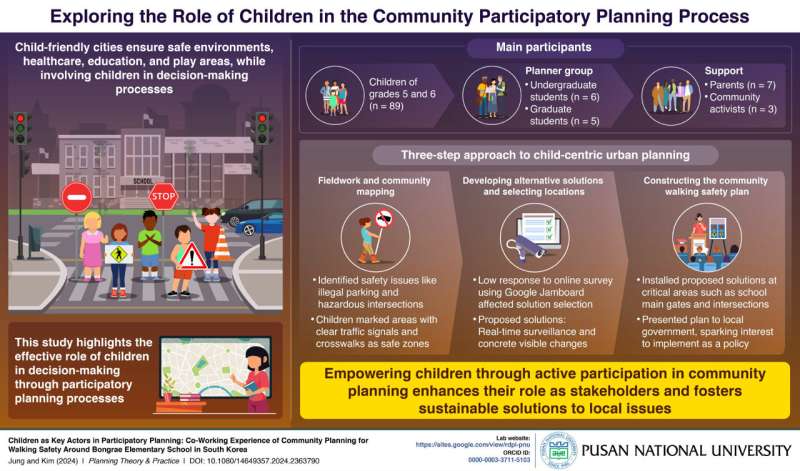KIDZ LIBERATION DEMANDS INPUT
Researchers explore the role of children in community participatory planning process

The United Nations Convention on the Rights of the Child defined child-friendly cities as those that prioritize children's access to safe environments, health care, education, green spaces, and the right to participate in decision-making processes about their surroundings.
Despite the importance, children are often overlooked in urban planning, consulted mainly for ideas rather than being actively involved in implementation of the ideas. Involving children fosters community interaction and enhances their understanding of how physical environments impact well-being. However, despite these benefits, children often face exclusion from public spaces due to limited capacity for independent movement and physical activity.
Recently, researchers from Pusan National University, led by Professor Donghyun Kim, Associate Professor at the Department of Urban Planning and Engineering, aimed to address this gap. Their study focused on conducting a participatory planning process with children and applying the findings to improving walking safety in a school zone in Busan. This study was published online on 17 June 2024 in the journal of Planning Theory & Practice.
Dr. Kim explains, "Our study aims to construct a community participatory planning process involving children and apply this planning process to a case related to the road safety problem of the school zone."
The study used a three-step participatory community planning process, which was designed based on interactions between the planner (comprised of six undergraduate and five graduate students from the Department of Urban Planning and Engineering at Pusan National University) and participants (89 children of grades 5 and 6). Initially, both planner and participant groups conducted separate field work and community mapping exercises.
Despite initial challenges, the children effectively identified various walking safety risks, such as illegal parking zones, intersections, unsafe crosswalks near their school, which were mapped and discussed using online tools like KakaoTalk Open Chat. All the identified spaces were congested with heavy vehicle movement in unpredictable directions and speeds.
In the second step, the planner group reviewed their findings and developed multiple solutions for the identified problems. Children rank preferences among the proposed solutions based on safety, impact, convenience, and cost, through an online survey. Sites for selected solutions including pedestrian-first streets, raised crosswalks, painted sidewalks, and bollards to prevent illegal parking, were then marked using Google Jamboard.
The final step involved creating a comprehensive community walking safety plan. Combining the survey results, the planners proposed installing pedestrian-first streets, painting sidewalks, adding bollards, marking crosswalks, and installing parking entrance alarms in and around the school area. This plan was then presented to the local government and local council and proposed as a policy.
The study highlighted how children successfully took part in participatory planning, despite challenges posed by restrictions due to COVID-19 and varying participant interest. Community maps, virtual tools, and shared understanding acted as effective tools in effectively utilizing children's participation.
Dr. Kim points out, "Our study shows that children can be the main actors in planning for community issues. The communicative planning process proposed in our study can be applied to bridge the gap between planners and residents in solving problems of various themes such as pedestrian safety problems for children, community renewal, and community climate change adaptation."
This urban planning approach empowers children, enabling their unique perspectives to contribute to the creation of safer and more inclusive environments.
More information: Bo-Kyung Jung et al, Children as Key Actors in Participatory Planning: Co-Working Experience of Community Planning for Walking Safety Around Bongrae Elementary School in South Korea, Planning Theory & Practice (2024). DOI: 10.1080/14649357.2024.2363790
No comments:
Post a Comment